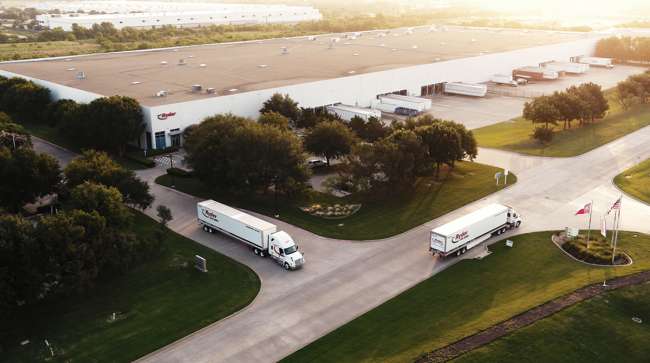How Shippers Navigate Risk in a Fragmented Freight Market

[Stay on top of transportation news: Get TTNews in your inbox.]
Small carriers make up a significant amount of available trucking capacity, but accessing that capacity presents unique challenges for shippers, especially when booking short-term or one-off loads in the spot market.
Shippers and logistics providers are stepping up efforts to vet and verify carriers to ensure safety and reliability amid increasing delivery expectations and ongoing concerns with freight fraud.
Lou Amo, president of truck brokerage for RXO, said the procurement process is filled with complexities in a truckload market that is massive and incredibly fragmented.
“Plus, a vast majority of carriers are small trucking companies, meaning there is a decent amount of churn in response to freight market conditions,” he explained.
Cody Griggs, vice president of digital brokerage for C.H. Robinson, said 90% of carriers have five trucks or less, and 60% are owner-operators. “Being on the shipper side and trying to manage all those relationships is difficult,” she said.
Major Issues
The top challenges within the spot market center around service degradation, capacity availability, and potentially higher theft and fraud risk.
“Carriers primarily prefer contract freight that has predictability and consistent volume, so that they can plan drivers, revenue and build out a much more stable business model,” said Kevin Clonch, group director, global transportation procurement for Ryder System.
Although there are differences between carriers, they aren’t always clear. Chris Burroughs, president and CEO of the Transportation Intermediaries Association, noted that carrier selection is a nuanced, often technical process.
David Bell, CEO of CloneOps.ai, discusses the impact of AI on the trucking industry. Tune in above or by going to RoadSigns.ttnews.com.
“[It’s] always exceedingly complex subject due to the innumerable differences among motor carriers who may appear the same on the outside to the general public and yet, to professional users, offer far different services,” he said.
Shippers’ standards have always been high, said Tracy Urbanski, senior vice president of operations for Penske Logistics, but they are even higher today, and some industries have stricter requirements than others.
“You don’t shut down manufacturing, and perishable goods are perishable by nature. So, there are spaces where we see financial penalties more frequently,” she said. “You see it in the automotive space, and that’s been standard for a lot of years, but you’re starting to see it in the consumer space, the CPG space.”
An independent study by RXO, which ranks No. 7 on the Transport Topics list of the top freight brokerage firms, found that 85% of shippers have on-time, in-full requirements (OTIF). “We asked these shippers how OTIF impacts their procurement strategy — 94% of shippers say it has at least some impact on the carriers they choose and 35% said it has a significant impact,” Amo said.

Angle
Adam Angle, senior vice president for ITS Logistics, said he is seeing more time requirements on both pickup and delivery times.
“You’re definitely seeing that customers can have that expectation on both sides of the linehaul, which really helps their network be more efficient and maximize what’s going on between their four walls,” he said.
Tracking the Freight
Bryan McAnally, vice president of capacity solutions at Redwood Logistics, noted that shippers also want visibility into their freight.
“As consumers, we have gotten very used to real-time tracking visibility and updates,” he said. “This expectation has worked its way upstream over time and is becoming more standardized as a service requirement.”
However, it is no longer enough to know where a truck is. “They want to know how much of what they ordered is on the truck. We’re helping them manage their inbound supply flow because, a lot of times, there is a black hole of what’s on that truck,” C.H. Robinson’s Griggs said, adding that shippers need context around data. “It’s one thing to know what truck is in St. Louis. It’s another thing to know it’s supposed to be in Kansas City in an hour.”
Want more news? Listen to today's daily briefing above or go here for more info
Visibility can also boost resiliency, which has become a more significant priority for shippers. “Customers are asking for us as a 3PL or 4PL to be resilient, to be agile, and to be able to get them visibility as soon as we know there is a chink in the armor,” Urbanski said. “In doing that, they’re asking everybody to level up and be more proactive.”
Angle told TT that shippers’ demands range from electronic data interchange and Safety Measurement System compliance to more specific requests.
“The biggest pushes are for better technology connections, increased speed, and higher on-time pickup and delivery expectations,” Angle said, adding that shippers are getting almost everything they ask for in today’s market. “We have customers that go above and beyond. They’ll go as far as on-site inspections and specific requirements for drivers — PPE, speaking certain languages.”
According to McAnally, connectivity should be viewed as a two-way street, “eliminating as many touches as possible while letting both parties do their job and manage by exception.”
In addition to sourcing the right carriers, shippers and 3PLs operating in the spot market must track the market and change due to seasonality, weather, industry conditions and geographic volatility. “If you are not closely monitoring those conditions, it is possible that you could quickly end up with no capacity availability and ultimately higher costs,” Clonch explained.
Finding the Right Partner
Shippers don’t always have the time or resources to conduct the level of due diligence needed to vet and manage carriers, and they are increasingly turning to third parties to help them. “This is the value add for the shippers to utilize brokers, as brokers have databases of thousands of motor carriers who are vetted appropriately to safely and efficiently move their freight,” Burroughs said.
He added that the Federal Motor Carrier Safety Administration’s inability to properly assign safety ratings to motor carriers makes the selection process even harder.
“Due to the fact that FMCSA utilizes an antiquated safety rating system done by physical audits, 92% of motor carriers are considered unrated,” Burroughs said. “This creates confusion and conflicting information in the carrier selection process and requires brokers and shippers to essentially second guess the federal agency.”
Brokers and logistics providers have insights shippers can’t get on their own, Griggs explained. “We’re managing hundreds of thousands of carriers and understand what they’re legally capable of, what their compliance is, what insurance coverage they have and how they performed on the last loads,” Griggs said, adding that C.H. Robinson tiers carriers into three groups through its Carrier Advantage Program based on service levels, visibility and volume. McAnally said Redwood Logistics has a five-step onboarding process for carriers.
“By the time we have analyzed email addresses, cross-checked phone numbers, validated VIN numbers, checked against our risk assessment and bounced the carrier profile against carrier vetting vendors, it feels like we are part-time detectives,” he noted.

While technology is integral to the vetting process, the human touch on every spot load is essential. (C.H. Robinson)
ITS Logistics also looks at the length of time and history of a trucking company’s motor carrier number. “That is our first trigger. We find newer carriers contribute to the vast majority of the fraud,” Angle said, adding the approval process for a new spot carrier is rigorous. “It’s very laborious on our team, because that’s where you see the highest risk.”
While technology is integral to the vetting process, Angle said the human touch on every spot load is essential.
“You can have all the best tools, practices and industry-leading support, but it’s our human at the end of the day that’s talking to that carrier and has that sixth sense,” he said.

Urbanski
Evaluating carriers is an ongoing process, said Urbanski, noting Penske continually evaluates carriers’ safety and security. “I can’t place enough emphasis on how important compliance is,” she cautioned. “The bad guys get craftier and craftier.”
Ryder has found it’s most successful with carriers operating other portions of its business contractually. “Consistently relying on one-and-done providers can lead to service degradation or unnecessary risks to claims, offsetting any potential savings achieved through spot,” Clonch said.
Penske also turns first to carriers the company has used in the past. “Ultimately, we know and can count on their service, their competitive rates and their track record,” Urbanski said, adding that Penske also looks at spot carriers as future contract carriers. “It gives them a chance to prove to us they did the things they said they were going to do.”
Vendor Performance
The RXO study found that shippers evaluate carriers’ prior performance when considering them for a freight quote or to participate in a bid, with 57% of shippers reporting they always take performance into account when deciding on a carrier and an additional 41% saying they do at least sometimes.
Sourcing carriers for irregular spot lanes can require brokers to go deeper into their carrier network to source capacity, which requires more carrier outreach and effort to get carriers in the system, McAnally said.
Once carriers are on board, Redwood Logistics utilizes monthly vendor scorecards that measure on-time pickup and delivery, tender acceptance, customer diversity, revenue, total load count, claims and connectivity — EDI, visibility tracking and accounts payable software.
Urbanski said carriers need to be aware of the requirements before they accept a load and make sure the communication is transparent.
“It’s completely unfair to hold someone to an expectation that they don’t necessarily understand,” she said. “When they get a tender from us, they know the pickup time requirements, delivery requirements and operational requirements.”
(C.H. Robinson via YouTube)
C.H. Robinson uses artificial intelligence and machine learning algorithms to match carriers’ capabilities and service levels with a load’s requirements, speeding up the process for shippers and carriers. “We can help a dispatcher find a load four times faster than if they were finding it on their own,” Griggs said. C.H. Robinson ranks No. 1 in the TT list of top freight brokerage firms.
Like shippers, carriers can also benefit from brokers’ size and capabilities.

Clonch
“Typically, you’ll find that the majority of the carriers who operate in the spot market are smaller carriers that need backhauls into their home markets,” Clonch said.
Cash flow is critical, and C.H. Robinson has invested in payment and product services for carriers, including its Digital Cash Advance that allows carriers to get 60% of their pay after picking up a load. “There’s a large amount of optionality for them to have access to their funds,” Griggs said.
Price Versus Quality
While many factors influence the carrier selection process, Amo said it is ultimately a function of price and service. “Getting the cheapest rate is one thing, but quality service comes from trust built over an established working relationship,” he said. “It is good to have a few options for spot carriers, but you want to keep the list to a reasonable length, and know where each carrier excels — service, rate, region, equipment type, etc.”
In the RXO study, 60% of shippers said they have gotten more demanding with their carriers to keep up with the increasing desire for faster, cheaper shipping. “This is up from 57% when we ran the same study back in 2022,” Amo said.
Clonch warned that cheaper is not always better. “The focus should be on the overall value a provider can bring to the table,” he said. “Service disruptions, claims, communication gaps with your end customer, and time taken away to manage problems can be costly and should be factored in when choosing carrier partners.”





